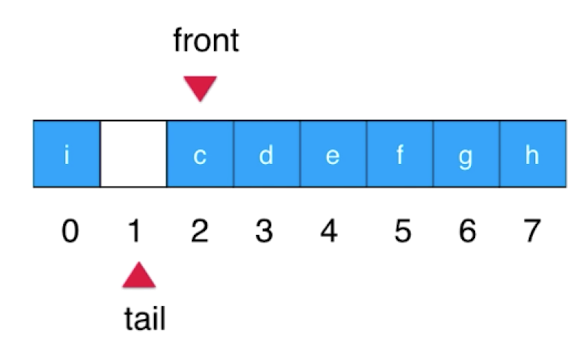
数组队列出队的时间复杂度为 O(n) 循环队列出队为 O(1)(均摊时间复杂度,因为缩容时时间复杂度还是 O(n))
数组队列在删除队首元素时后面的元素要往前移动,比较耗时,循环队列使用 front 指针后移无需移动后面元素,
出队腾出的空间会在最后位置填充时利用。
tail == front 时队列为空,tail 指针要保证指向空间没有元素
实现
public class LoopQueue<E> implements Queue<E> {private E[] data;private int front, tail;private int size;public LoopQueue(int capacity) {data = (E[])new Object[capacity + 1];front = 0;tail = 0;size = 0;}public LoopQueue() {this(10);}public int getCapacity() {return data.length - 1;}@Overridepublic int getSize() {return size;}@Overridepublic boolean isEmpty() {return front == tail;}@Overridepublic void enqueue(E e) {if ((tail + 1) % data.length == front) {resize(getCapacity() * 2);}data[tail] = e;tail = (tail + 1) % data.length;size ++;}private void resize(int newCapacity) {E[] newData = (E[])new Object[newCapacity + 1];for (int i = 0; i < size; i ++) {newData[i] = data[(i + front) % data.length];}data = newData;front = 0;tail = size;}@Overridepublic E dequeue() {if (isEmpty()) {throw new NoSuchElementException("Cannot dequeue from an empty queue!");}E ret = data[front];data[front] = null;front = (front + 1) % data.length;size --;// 缩容if (size == getCapacity() / 4 && getCapacity() / 2 != 0){resize(getCapacity() / 2);}return ret;}@Overridepublic E getFront() {if (isEmpty()) {throw new NoSuchElementException("Cannot dequeue from an empty queue!");}return data[front];}@Overridepublic String toString() {StringBuilder res = new StringBuilder();res.append(String.format("Queue: size = %d, capacity = %d\n", size, getCapacity()));res.append("front: [");for (int i = front; i != tail; i = (i + 1) % data.length) {res.append(data[i]);if ((i + 1) % data.length != tail) {res.append(", ");}}res.append("] tail");return res.toString();}public static void main(String[] args) {LoopQueue<Integer> queue = new LoopQueue<>();for (int i = 0; i < 10; i++) {queue.enqueue(i);System.out.println(queue);if (i % 3 == 2) {queue.dequeue();System.out.println(queue);}}}}

